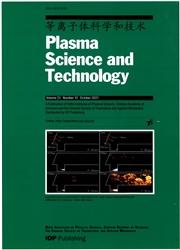Characteristics of the SOL ion-to-electron temperature ratio on the J-TEXT tokamak with different plasma configurations
IF 1.8
3区 物理与天体物理
Q3 PHYSICS, FLUIDS & PLASMAS
引用次数: 0
Abstract
Abstract Accurate measurements of the edge plasma equilibrium profiles, including the temperature and density of electrons and ions, are critical to understanding the characteristics of the scrape-off layer (SOL) and divertor plasma transport in magnetically confined fusion research. On the J-TEXT tokamak, a multi-channel retarding field analyzer (RFA) probe has been developed to study edge plasma equilibrium profiles under various poloidal divertor and island divertor configurations. The edge radial profile of the ion-to-electron temperature ratio, τ_{i/e}, has been determined, which gradually decreases as the SOL ion self-collisionality, ν_{SOL}^*, increases. This is widely consistent with what has been observed previously from various tokamak experiments. However, the comparison of experimental results under different configurations shows that in the poloidal divertor configuration, even under the same ν_{SOL}^*, τ_{i/e} in the SOL region becomes smaller as the distance from the X-point to the target plate increases. In the island divertor configuration, τ_{i/e} near the O-point is higher than that near the X-point at the same ν_{SOL}^*, and both are higher than the limiter configuration. These results suggest that the magnetic configuration plays a critical role in the energy distributions between electrons and ions at the plasma boundary.J-TEXT托卡马克不同等离子体构型下SOL离子电子温度比的特性
精确测量边缘等离子体平衡曲线,包括电子和离子的温度和密度,对于理解磁约束聚变研究中刮擦层(SOL)和分流体输运的特性至关重要。在J-TEXT托卡马克上,研制了一种多通道延迟场分析仪(RFA)探针,用于研究不同极性和岛型分流器配置下的边缘等离子体平衡分布。离子-电子温度比τ_{i/e}的边缘径向分布随着溶胶离子自碰撞ν_{SOL}^*的增大而逐渐减小。这与以前从各种托卡马克实验中观察到的结果广泛一致。然而,不同配置下的实验结果对比表明,在极向导流器配置下,即使在相同的ν_{SOL}^*下,随着x点到目标板的距离增加,SOL区域的τ_{i/e}也变小。在岛型导流器构型中,在相同的ν_{SOL}^*处,o点附近τ_{i/e}大于x点附近τ_{i/e},且两者均高于限流器构型。这些结果表明,磁组态在等离子体边界电子和离子之间的能量分布中起着关键作用。
本文章由计算机程序翻译,如有差异,请以英文原文为准。
求助全文
约1分钟内获得全文
求助全文
来源期刊

Plasma Science & Technology
物理-物理:流体与等离子体
CiteScore
3.10
自引率
11.80%
发文量
3773
审稿时长
3.8 months
期刊介绍:
PST assists in advancing plasma science and technology by reporting important, novel, helpful and thought-provoking progress in this strongly multidisciplinary and interdisciplinary field, in a timely manner.
A Publication of the Institute of Plasma Physics, Chinese Academy of Sciences and the Chinese Society of Theoretical and Applied Mechanics.
 求助内容:
求助内容: 应助结果提醒方式:
应助结果提醒方式:


